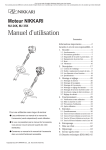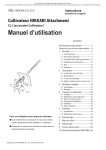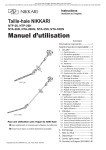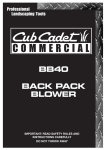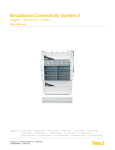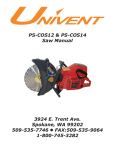Download Ybravo BRAVO 65-101 Operator`s manual
Transcript
OPERATOR’S MANUAL BRAVO 65 Blower Model: 65-101 Operator’s Manual Read these instructions carefully and make sure you understand them before using the BRAVO 65. P/N 990020-1 Rev. 08/2009 INTRODUCTION Careless or improper use of this blower can cause serious or even fatal injury. Carefully read, understand and follow ALL instructions in this manual before using the BRAVO 65 Blower. Allow only competent adults to operate this blower. It is the owner’s responsibility to ensure that all operators of this blower have read and understand the content of this manual. Common sense: The focus of this manual is HOW to operate and service the equipment safely. It is not possible to cover every conceivable situation you can face when using this blower. Therefore use this product only in a manner described in this manual. Operation or handling the machine in any other manner can lead to serious injury or death. If a situation is not described in this manual it should be considered dangerous - and not be done. If you are unfamiliar with this product make sure that you carefully understand how it functions and practice all operations and handling before putting the machine to use. Familiarize yourself in the presence of an experienced operator. Avoid all situations that are beyond your capability. If you still feel uncertain about the operating procedures after reading these instructions DO NOT operate the machine until you have consulted an experienced operator. If you have further questions you can contact - Ybravo.com, by writing or calling, see information below. You may also find a dealer close to you by searching the internet at: www.ybravo.com Ybravo.com, will willingly be of service and provide you with advice as well as help you to use your product both efficiently and safely. Additional manuals are available at NO CHARGE and can also be obtained on the internet site. Ybravo.com, LLC P.O.Box 2209 Livermore CA 94551 USA Toll Free #: Phone #: Fax #: Internet Site: 888 ybravo1 (888 927 2861) 925 961 8750 925 961 8770 www.ybravo.com PERSONAL SAFETY EQUIPMENT When working and operating garden equipment - approved personal safety items should be used: Hearing Protection Eye Protection Respiratory Protection Protective Gloves Protective Shoes WARNING NOTICE CALIFORNIA Proposition 65 Warning The engine is equipped with a spark arrester in the muffler. It is a violation of California Public Resource Code Section 4442 to use or operate the engine on any forest-covered, brush-covered, or grass-covered land. Other states or federal areas may have similar laws. Be aware of local laws and regulations. Spark arresters are available from Ybravo.com. The engine exhaust from this product contains chemicals known to the State of California to cause cancer, birth defects or other reproductive harm. 2 SAFETY DEFINITIONS In this manual a Safety Alert Symbol followed by the signal words WARNING and CAUTION are used to identify safety information about hazards which can result in death, serious injury and/or property damage. These signal words mean: WARNING indicates a hazard which, if not avoided, could result in death or serious injury. CAUTION indicates a hazard which, if not avoided, might result in minor or moderate injury. NOTICE indicates a message not related to personal injury. SAFETY HAZARDS WARNING DO NOT MODIFY THE PRODUCT Under no circumstances may the design of the machine be modified without the permission of the manufacturer. Always use genuine parts and accessories. Unauthorized modifications, parts and/or accessories can result in serious personal injury or the death of the operator or others. Your warranty may not cover damage or liability caused by the use of unauthorized accessories or replacement parts. WARNING CAUTION ASPHYXIATION HAZARD Running an engine in a confined or badly ventilated area can result in injury or death due to asphyxiation or carbon monoxide poisoning. HEARING HAZARD During the normal use of this machine, operator may be exposed to a noise level equal to or higher than 85 dB(A). Use hearing protection. REGISTER THE PRODUCT Please register your new blower with Ybravo.com, by mailing in a copy of this page together with your address information or (better) register the blower online at the internet site: www.ybravo.com Registration will allow us to contact you in case of any critical updates or recalls on this machine. Product registration has been found helpful in tracing stolen equipment. Record the following information for your records: PURCHASE DATE: ________________ MODEL No: _______________________ SERIAL No: ________________________ The blower model and serial number are critical in order to obtain the correct service parts. Ybravo.com has service parts available as listed in the spare parts list. All engine parts are available from Ybravo.com and through the Kawasaki engine dealer network. Mail information: Name: ______________________________________________ Street Address: _______________________________________ City, State, Zip Code: ___________________________________ 3 EMISSION CONTROL CONTENTS Content Page Introduction, personal safety ...................... General safety message............................. 2 2-3 Registration of the product ......................... 3 Table of contents ........................................ Emission control information....................... 4 4 Maintenance and Warranty Proper maintenance is necessary to ensure that your engine will continue to have low emission levels. This Operator’s Manual contains those maintenance recommendations for your engine. Those items identified in the maintenance section are necessary to ensure compliance with the applicable standards. As the owner of the blower, you have the responsibility to make sure that the recommended maintenance is carried out according to the instructions in this Operator’s Manual at your own expense. The Ybravo.com Warranty requires that you return your blower to an authorized Kawasaki or Ybravo.com dealer for remedy under warranty. Please read the warranty carefully, and keep it valid by complying with the owner’s obligations it contains. The machine’s safety equipment ................ 5 General safety precautions ........................ 5-6 General working instructions ...................... 6 What is what on the blower ......................... 7 Assembly of the blower ............................... 7 Engine Emissions Compliance Period Fuel handling ............................................... 8 Fuel mixture ................................................. 8 Fueling ......................................................... 8 California Model Year – 2000 and later Durability Period – 300 hours Start and stop .............................................. 9 Maintenance ................................................ 10 Muffler Cooling system Air filter Spark plug All Other States Engines 50cc and more Model Year – 2004 and later Durability Period – 300 hours (Category A) If your engine has an assigned emissions durability period it will be located on the certification label attached to the engine. Tampering with emission controls system prohibited Federal law and California State law prohibits the following acts or the causing thereof: (1) the removal or rendering inoperative by any person other than for purposes of maintenance, repair, or replacement, of any device or element of design incorporated into any new engine for the purposes of emission control prior to is sale or delivery to the ultimate purchaser or while it is in use, or (2) the use of the engine after such device or element of design has been removed or rendered inoperative by any person. Among those acts presumed to constitute tampering are the acts listed below: Do not tamper with the original emission related parts: Maintenance schedule ................................ 11-12 Technical data ............................................. 13 Warranty statement ..................................... 15 EMISSION CONTROL EMISSION CONTROL INFORMATION - Fuel information THIS ENGINE IS CERTIFIED TO OPERATE ON UNLEADED REGULAR GRADE GASOLINE ONLY. Use a minimum of 87 octane. The engine will not operate on gasoline marketed as E-85 (85% ethanol) Emission control information To protect the environment in which we all live, Kawasaki has incorporated an exhaust emission control system in compliance with applicable regulations of the United States Environmental Protection Agency and the California Air Resources Board. Also, depending on when your engine was produced, it may have an assigned emission durability period. See below for the engine emissions durability period that applies to your engine. Exhaust emission control system This system reduces the amount of pollutants discharged into the atmosphere by the exhaust of this engine. The fuel, ignition and exhaust systems of this engine have been carefully designed and constructed to ensure an efficient engine with low exhaust pollution levels. 4 Carburetor and internal parts Spark plug Magneto or electronic ignition system Fuel filter Muffler or any internal portion of the muffler Air cleaner element SAFETY INSTRUCTIONS General safety precautions 2. Vibration damping system IMPORTANT INFORMATION - Never use the machine if you are tired, if you have drunk alcohol, or if you are taking medication that could affect your vision, your judgement or your coordination. Your machine is equipped with a vibration damping system, which is designed to give as vibration-free and comfortable use as possible. The machine’s vibration damping system reduces the transfer of vibrations. - Wear personal protective equipment. See instructions under the heading Personal Safety Equipment page 2. WARNING - Never use a machine that has been modified in any way from its original design. Over exposure to vibrations can result in blood-vessel or nerve injury to persons suffering from blood circulation problems. Seek medical attention if you experience physical symptoms that can be related to over exposure to vibrations. Examples of such symptoms are “numbness”, “lack of feeling”, “tickling”, “pricking”, “pain”, lack of or a reduction in normal strength, changes in the color of the skin or its surfaces. These symptoms normally appear in the fingers, hands, or wrists. Never use a machine with defective safety equipment. Follow the inspection, maintenance and service instructions described in this section. - Never use a machine that is faulty. Follow the checks, maintenance and service instructions described in this manual. Some maintenance and service must be carried out by trained and qualified specialists. See instructions under the heading Maintenance page 10. - All covers and guards must be fitted before starting the blower. Make sure the spark plug cap and high tension wire lead are not damaged. An electric shock can result from if the components are damaged. - The operator of the blower must ensure that no people or animals are any closer than 50 feet (15 meters) to the work area. Never point the blower nozzle toward people or animals. Inspection: Check the vibration damping element regularly for material cracks and distortion. - The blower may throw objects at high velocity that can ricochet and hit the operator. This can cause serious eye damage. Check that the vibration damping element is undamaged and securely attached. The machine’s safety equipment 3. Muffler This section describes the machine’s safety equipment, its function and how checks and maintenance are carried out to ensure that it operates correctly. See the chapter “What is what” page 10 to locate where this equipment is positioned on your machine. The muffler is designed to give the lowest possible noise level and to direct the engine’s exhaust fumes away from the operator. In warm and dry climate, the risk of fire is obvious. Therefore the muffler has a spark arrestor screen. Always make sure that your muffler is fitted with the spark arrestor screen. Follow the instructions for the maintenance of the muffler described in this manual. WARNING Never use a machine with defective safety equipment. Follow the inspection, maintenance and service instructions described in this section. Inspection: Never use a machine that has a defective muffler. 1.Stop switch Check regularly that the muffler is secure. The stop switch should always be used to stop the engine. A blocked screen can cause the engine to overheat with serious damage as a result. Never use a muffler with a defective spark arrestor screen. Verify function: Start the engine and make sure that the engine stops when the stop switch is pushed into the OFF position. 5 SAFETY INSTRUCTIONS General working instructions Fuel safety Show consideration to persons in your surroundings by avoiding using the machine at unsuitable times, such as late in the evening or early in the morning. Read through and follow the simple directions so that you disturb your surroundings as little as possible. - Always use a fuel container with an anti-spill valve. - Never refuel the machine while the engine is running. Always stop the engine and let it cool for a few minutes before refuelling. - Use the blower with the lowest possible throttle. It is seldom necessary to use full throttle, and many work procedures can be done at half throttle. A lower throttle means less noise and less dust, and it is also easier to keep control over the rubbish collected together/moved. - Make sure there is plenty of ventilation when refuelling or mixing fuel (petrol and 2-stroke oil). - Avoid all skin contact with fuel. Fuel is a skin irritant and may even cause injury to the skin. - Use a rake or a brush to release rubbish stuck to the ground. - Move the machine at least 10 feet (3 meters) from the refuelling point before starting it. - Hold the opening of the blower as close to the ground as possible. - Observe your surroundings. If anyone approaches your work area, set the throttle control to the lowest throttle until the person is at a safe distance. Direct the blower away from people, animals, play areas, and cars etc. - Clean up afterwards. Make sure that you have not blown rubbish into someone’s garden. - No unauthorized persons or animals may be present in the working area, which is 50 feet (15 meters). Never start the machine if: - If you spill fuel on the blower. Wipe off any spillage and allow remaining fuel to evaporate. - If you spill fuel on yourself or your clothes, change your clothes. Wash any part of your body that has come in contact with fuel. Use soap and water. - If the machine is leaking fuel. Check regularly for leaks from the fuel cap and fuel lines. - The powerful currents of air can move objects at such a speed that they can bounce back and cause serious eye injuries. Transport and storage - Store and transport the machine and fuel so that there is no risk of any leakage or fumes coming into contact with sparks or naked flames, for example, from electrical machinery, electric motors, electrical relays/switches or boilers. - Do not direct the air jet towards people or animals. - Stop the engine before assembling or dismantling accessories or other parts. - Do not use the machine in bad weather, such as dense fog, heavy rain, strong wind, intense cold, etc. Working in bad weather is tiring and can lead to dangerous conditions, e.g. slippery surfaces. - When storing and transporting fuel always use approved containers intended for this purpose. - When storing the machine for long periods the fuel tank must be emptied. Contact your local petrol station to find out where to dispose of excess fuel. - Make sure you can move and stand safely. Check the area around you for possible obstacles (roots, rocks, branches, ditches, etc.) in case you have to move suddenly. Take great care when working on sloping ground. - Ensure the machine is cleaned and that a complete service is carried out before long-term storage. - Never put the machine down with the engine running unless you have it in clear sight. - Engine exhaust fumes contain carbon monoxide, which can cause carbon monoxide poisoning. For this reason you should not start or run the machine indoors, or anywhere that is poorly ventilated. - The blower must not be used while on a ladder or scaffolding. 6 WHAT IS WHAT What is what on the blower? 1. 2. 3. 4. 5. 6. 7. 8. 9. 10. 11. 12. 13. Spark plug Choke Air filter Starter handle Fuel tank Harness Muffler/Spark arrestor screen Throttle control arm Nozzle Blow tube Throttle control Stop switch Operator’s Manual Assembly of the blower 1. 2. 3. 4. Connect the flexible hose (A) to the fan’s outlet tube (B) with a hose clamp. Fit the control handle (D) on the operating tube (C) with the enclosed hose clamp. Connect the operating tube (C) to the flexible hose with a hose clamp. Connect the intermediate tube (E) and air nozzle tube (F) Push the tubes together and turn them so that they lock together. 7 FUEL HANDLING Mixing - Always mix the gasoline and oil in a clean container intended approved for gasoline. WARNING Taking the following precautions will lessen the risk of injury and property damage. Use extreme care in handling gasoline. Gasoline is extremely flammable and the vapors are explosive. - Always start by filling half the amount of the gasoline to be used, then add the entire amount of oil. Add the remaining amount of gasoline. - Extinguish all cigarettes, cigars, pipes, and other sources of ignition. - Use only approved gasoline container. - Never remove gas cap or add fuel with the engine running. Allow engine to cool a minimum of 3 minutes before refueling. - Never fuel the machine indoors. - Never store the machine or fuel container where there is an open flame, spark, or pilot light such as on a water heater or other appliances. - Never fill containers inside a vehicle or on a truck or trailer bed with a plastic liner. Always place containers on the ground away from your vehicle when filling. - Remove the blower from the truck or trailer and refuel it on the ground. If this is not possible, then refuel the equipment with a portable container, rather than from a gasoline dispenser nozzle. - Keep the nozzle in contact with the rim of the fuel tank or container opening at all times until fueling is complete. Do not use a nozzle lock-open device. - If fuel is spilled on clothing, change clothing immediately. - Never overfill fuel tank. Always wipe off any spilled fuel or oil. Replace fuel cap and tighten Gasoline U.S. gallon 1 2.5 5 Two-stroke oil 50:1 (2%) U.S. fl.oz 2.5 oz 6.5 oz 13 oz - Mix (shake) the fuel mixture thoroughly before filling the machine’s fuel tank. - Do not mix more than one month’s supply of fuel at a time. - If the machine is not used for some time, the fuel tank should be emptied and cleaned. NOTICE - Move the blower at least 10 feet (3 meters) from the refuelling point before starting . The machine is equipped with a two-stroke engine and must always been run using a mixture of gasoline and two-stroke engine oil It is important to accurately measure the amount of oil to be mixed to ensure that the correct mixture is obtained. - Clean the area around the fuel cap. Contamination in the tank can cause operating problems. Gasoline Use a minimum of 87 octane gasoline purchased within 4 weeks of usage The engine will not operate on gasoline marketed as E-85 (85% ethanol) - The lowest recommended octane rating is 87. If you run the engine on a lower octane rating than 87, “knocking” can occur. This leads to an increased engine temperature, which can result in a serious engine failure. - When working at continuous high RPM’s a higher octane rating is recommended. Two-stroke oil - Use ONLY two-stroke oil specially formulated for air cooled small engines at a mixture of 50:1 (2%). - Never use two-stroke oil intended for water-cooled outboard engines, sometimes referred to as outboard oil. - Never use oil intended for four-stroke engines. 8 STARTING AND STOPPING When starting Following the procedure for cold and warm engine start; - Press the machine body against the ground using your left hand (NOTE! Not your foot). - Grip the starter handle, slowly pull out the cord with your right hand until you feel some resistance (the starter pawls grip) - Quickly and powerfully pull the cord. Starting a cold engine Ignition: Set the stop switch to the “ON” position (button in the upper position) Choke Lever: Push the choke lever up to set the choke Notice: Do not release the starter cord from the fully extended position. This can damage the machine. Air purge bulb: Press the air purge bulb repeatedly until fuel begins to flow through the overflow tube typically after 5 to 10 times. Throttle control: Open the throttle control to about 1/3 throttle Starting a warm engine; Ignition: Set the stop switch to the “ON” position (button in the upper position) Air purge bulb: Press the air purge bulb repeatedly until fuel begins to flow through the overflow tube typically after 5 to 10 times. Notice: In hot conditions the fuel can evaporate out of the carburetor after shutting off the machine. This results in hard starting even if the engine is warm. By using the air purge the carburetor is refilled with fuel. The engine will not get flooded by using the air purge. Stopping the engine Ignition: Push the stop switch to the “OFF” position. Notice: Always let the engine return to an idle speed for 10 seconds before pushing the stop button. This allows the engine to cool down gradually. This prolongs the life of some engine components. 9 MAINTENANCE Muffler Air Filter The muffler is designed to dampen the noise level and to direct the exhaust fumes away from the user. The air filter should be cleaned regularly removing dust and dirt to avoid: The exhaust fumes are hot and can contain sparks, which can result in fire if the exhaust fumes are directed towards a dry and flammable material. The mufflers are equipped with a special spark arrestor screen. It should be cleaned regularly. This is done using a wire brush. The screen should be cleaned weekly, or replaced if necessary. If the screen is damaged it should be replaced. A blocked screen can cause the engine to overheat resulting in damage to the cylinder and piston. Never use a machine with a damaged muffler Cooling System To maintain as low operating temperature as possible, the engine is equipped with a cooling system. The cooling system consists of: 1. An air intake on the blower housing. 2. Fins on the blower fan. 3. Cooling fins on the cylinder. 4. Cylinder cover (directs cold air onto the cylinder). - Carburetor malfunction - Starting problems - Reduced engine power - Unnecessary wear to engine parts - Abnormal fuel consumption Cleaning the Air Filter Dismantle the air filter cover and remove the air filter element. An air filter element used for a long period of time can never be cleaned completely. Therefore, it is necessary to replace the filter from time to time with a new filter element. A damaged air filter must always be replaced. Air Filter Element Clean the element every 20 hours. Clean the element by tapping gently to remove dust. If very dirty, replace the element with a new one. Replace with a new element yearly – 200 hours. In very dusty conditions more frequent maintenance may be required. Notice: Do not wash paper-element. Do not use pressurized air to clean or dry paper element. After servicing the air cleaner, be sure all the removed parts are reinstalled properly. Failure to secure the fastening of the air filter cover with the two screws may cause dirt or other foreign materials to enter the engine. Dirt entering the engine will cause premature engine wear and failure. Spark Plug The condition of the spark plug is affected by: Clean the cooling system using a brush weekly. In severe conditions more often. - An incorrect fuel mixture (too much or faulty oil). - A dirty air filter. - Poor quality gasoline. A dirty or blocked cooling system can cause the engine to overheat, resulting in damage to the cylinder and piston. These factors cause deposits on the spark plug electrode that may result in malfunction or starting difficulties. If the machine is low on power, difficult to start, or runs poorly while idling, always check the spark plug first. If the spark plug is dirty, clean it and, at the same time, check that the electrode gap is 0.030”. The spark plug should be changed after about one month of operation or earlier. Always use the recommended type of spark plug. An incorrect spark plug can damage the cylinder/piston. 10 MAINTENANCE SCHEDULE Daily Maintenance Monthly Maintenance 1. Clean the outside of the machine. 1. Clean the fuel tank. 2. 2. Check that the throttle control functions safely. Clean the carburetor and the area surround it. 3. 3. Check that the stop switch functions. Clean the air intake of the blower housing. 4. 4. Check that all nuts and screws are tightened. Check the fuel filter and the fuel line. Replace if necessary. 5. Check all cables and connections. Weekly Maintenance 1. Check the starter, the starter cord, and the return spring. 2. Make sure that the vibration damping elements are not damaged. 3. Clean the outside of the spark plug. Remove and check the electrode gap. Adjust the gap to 0.030” or change the spark plug. 4. Clean the air intake of the blower housing. 5. Clean or replace the muffler’s spark arrestor screen 6. Clean the carburetor area. 7. Clean the cooling fins on the cylinder. 11 MAINTENANCE SCHEDULE WARNING Accidental starting of the engine can cause injury. Always remove the spark plug cap before performing any service work to prevent accidental starting. When starting the blower the machine should always be completely assembled. Maintenance Intervals First 20 hours Daily Check and replenish fuel z Check for fuel leakage z Check for loose or missing bolts, nuts and screws z Check throttle lever operation z Check engine switch operation z Check shoulder harness condition z Every 50 hours Every 100 hours Every 200 hours z Clean fuel filter Clean air filter element * Every 20 hours z 1 z Tighten bolts, nuts and screws z z Clean spark plug and adjust electrode gap z Remove dust and dirt from cylinder fins Remove carbon deposits on piston head and inside cylinder *2 z z Remove carbon deposits in the muffler z Clean spark arrestor screen Check the condition of the crankshaft connecting rod etc. *2 z Fuel line It is recommended to replace every 3 years Notice: The service intervals should be used as a guide. (*1) The air filter should be cleaned more frequently in very dusty conditions. (*2) These items require proper tools and should only be performed by an authorized dealer. 12 TECHNICAL DATA Technical data BRAVO 65 Engine Cylinder displacement, cm3 Cylinder bore, mm Stroke, mm Idle speed, rpm Recommended max. speed Max. engine output, acc. to ISO 8893, kW/ rpm Catalytic converter muffler 64.7 48.5 35 2,500 7,000 3.0kW / 8000 (4.1 HP ) No Ignition system Type of ignition system Spark plug Electrode gap CDI Electronic NGK BPMR 7A - 9 0.030” (0.85 mm) Fuel system Manufacturer/type of carburetor Fuel tank capacity, U.S. Qt/Liter Walbro, diaphragm 2.1 / 2.0 Weight Weight without fuel and attachments Lbs/Kg 21.4 / 9.7 Noise emissions Equivalent noise pressure level at the operator’s ear, measured according to EN 31806 and ISO 7917 dB(A) 97 Equivalent noise power level at the operator’s ear, measured according to EN31806 and ISO 10884 dB(A) 105 Vibration levels Vibration levels at handles, measured according to EN 31806 and ISO 7916, m/s2 When idling, left/right handles, max: At maximum speed, left/right handles max: 1.2 1.2 13 NOTES 14 PRODUCT REGISTRATION & WARRANTY STATEMENT All Ybravo.com products can be registered online at www.ybravo.com quickly and easily. Click on the Product Registration tab and fill out the electronic form and submit. SECTION 1: LIMITED WARRANTY Ybravo.com (Ybravo) warrants the original purchaser of Ybravo branded product to which this warranty applys (the “Product”) that the Product shall be free from defects in material and workmanship from the date of purchase for the period of the applicable “Warranty Schedule” of the Product as set forth below. Additional limitations are described in Section 2 through Section 6, inclusive. Product Category Commercial Blowers Commercial Mowers Replacement Parts (Excludes components which are part of engine systems manufactured by third party engine manufacturers for which the purchaser has received a separate warranty with product at time of purchase.) Commercial Use Warranty Schedule 1 Year 1 Year Rental Warranty Schedule 90 Days 90 Days 60 Days 30 Days SECTION 2: YBRAVO’S OBLIGATIONS UNDER THE WARRANTY Ybravo.com will repair or replace defective components without charge for parts or labor if a component fails because of a defect in material or workmanship during the warranty period. SECTION 3: ITEMS NOT COVERED BY THIS WARRANTY The following items are not covered by this warranty: 1) Normal customer maintenance items which become worn through normal regular use, including, but not limited to, belts, blades, blade adapters, cables, clutches, clutch drums, filters (fuel line, fuel filters, air filters, oil filters), lubricants, rewind springs, spark plugs, and starter ropes. 2) Natural discoloration of material due to ultraviolet light; 3) Engine and drive systems not manufactured by Ybravo; these items are covered by the respective manufacturer’s warranty as provided in writing with the product information supplied at the time of purchase; all claims must be sent to the appropriate manufacturer. 4) Commercial mowing decks with sand abrasion damage. 5) Emission Control System components necessary to comply with CARB-TIER II and EPA regulations which are manufactured by third party engine manufacturer. SECTION 4: EXCEPTIONS AND LIMITATIONS This warranty shall be inapplicable to defects resulting from the following: 1) Accident, abuse, misuse, negligence and neglect, including stale fuel, dirt, abrasives, moisture, rust, corrosion, or any adverse reaction due to incorrect storage or use habits; 2) Failure to operate or maintain the unit in accordance with the Owner’s/Operator’s manual or instruction sheet furnished by Ybravo.com; 3) Alterations or modifications that change the intended use of the product or affects the product’s performance, operation, safety, or durability, or causes the product to fail to comply with any applicable laws; or: 4) Additional damage to parts or components due to continued use occurring after any of the above. REPAIR OR REPLACEMENT AS PROVIDED UNDER THIS WARRANTY IS THE EXCLUSIVE REMEDY OF THE PURCHASER. YBRAVO SHALL NOT BE LIABLE FOR ANY INCIDENTAL OR CONSEQUENTIAL DAMAGES FOR BREACH OF ANY EXPRESS OR IMPLIED WARRANTY ON THESE PRODUCTS EXCEPT TO THE EXTENT PROHIBITED BY APPLICABLE LAW. ANY IMPLIED WARRANTY OF MERCHANTABILITY OR FITNESS FOR A PARTICULAR PURPOSE ON THESE PRODUCTS IS LIMITED IN DURATION TO THE WARRANTY PERIOD AS DEFINED IN THE LIMITED WARRANTY STATEMENT. YBRAVO RESERVES THE RIGHT TO CHANGE OR IMPROVE THE DESIGN OF THE PRODUCT WITHOUT NOTICE, AND DOES NOT ASSUME OBLIGATION TO UPDATE PREVIOUSLY MANUFACTURED PRODUCTS. Some states do not allow the exclusion of incidental or consequential damages, or limitations on how long an implied warranty lasts, so the above limitations or exclusions may not apply to you. This warranty gives you specific legal rights, and you may also have other rights which vary by state. SECTION 5: CUSTOMER RESPONSIBILITIES The product must exhibit reasonable care, maintenance, operation, storage and general upkeep as written in the maintenance section of the Owner’s/Operator’s manual. Should an operational problem or failure occur, the product should not be used. Failure caused by continued use is not covered by warranty. Product should be delivered, at owners’ expense, as is, to an authorized Ybravo Dealer for evaluation. Proof of purchase, as explained in section 6, rests solely with the customer. SECTION 6: PROCEDURE TO OBTAIN WARRANTY CONSIDERATION It is the Owner’s and Dealer’s responsibility to make certain that the Product Registration was completed on-line at www.ybravo.com. Product Registration should be completed within ten (10) days from the date of purchase in order to confirm the warranty and to facilitate post-sale service. Proof of purchase must be presented to the authorized Ybravo dealer in order to obtain warranty service. This proof must include date purchased, model number, serial number, and complete name and address of the selling dealer. To obtain the benefit of this warranty, the product believed to be defective must be delivered to an authorized Ybravo dealer in a timely manner, no later than thirty (30) days from date of the operational problem or failure. The product must be delivered at the owner’s expense. Downtime, pick-up and delivery charges are not covered by this warranty. An authorized Ybravo dealer can be located by calling 1-888-YBRAVO-1 or by visiting www.ybravo.com. Subject to change without notice. 15

















